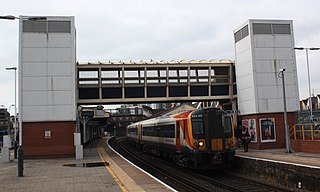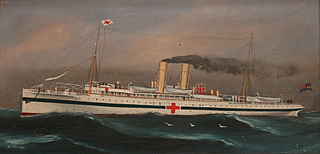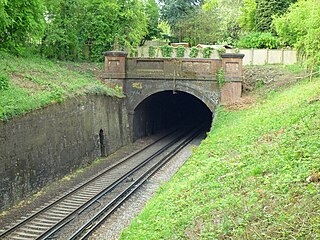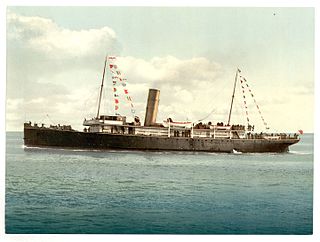
The Southern Railway (SR), sometimes shortened to 'Southern', was a British railway company established in the 1923 Grouping. It linked London with the Channel ports, South West England, South coast resorts and Kent. The railway was formed by the amalgamation of several smaller railway companies, the largest of which were the London & South Western Railway (LSWR), the London, Brighton and South Coast Railway (LB&SCR) and the South Eastern and Chatham Railway (SE&CR). The construction of what was to become the Southern Railway began in 1838 with the opening of the London and Southampton Railway, which was renamed the London & South Western Railway.

The London, Brighton and South Coast Railway was a railway company in the United Kingdom from 1846 to 1922. Its territory formed a rough triangle, with London at its apex, practically the whole coastline of Sussex as its base, and a large part of Surrey. It was bounded on its western side by the London and South Western Railway (L&SWR), which provided an alternative route to Portsmouth. On its eastern side the LB&SCR was bounded by the South Eastern Railway (SER)—later one component of the South Eastern and Chatham Railway (SE&CR)—which provided an alternative route to Bexhill, St Leonards-on-Sea, and Hastings. The LB&SCR had the most direct routes from London to the south coast seaside resorts of Brighton, Eastbourne, Worthing, Littlehampton and Bognor Regis, and to the ports of Newhaven and Shoreham-by-Sea. It served the inland towns/cities of Chichester, Horsham, East Grinstead and Lewes, and jointly served Croydon, Tunbridge Wells, Dorking and Guildford. At the London end was a complicated suburban and outer-suburban network of lines emanating from London Bridge and Victoria, and shared interests in two cross-London lines.

The Brighton main line is a major railway line in the United Kingdom that links Brighton, on the south coast of England, with central London. In London the line has two branches, out of London Victoria and London Bridge stations respectively, which join up in Croydon and continue towards Brighton as one line. The line is electrified throughout using the third rail system.

Coulsdon North is a closed railway station that served Coulsdon, Croydon, England, on the Brighton Main Line.

Redhill railway station serves the town of Redhill, Surrey, England. The station is a major interchange point on the Brighton Main Line, 22 miles 40 chains (36.2 km) measured from London Charing Cross. It is managed by Southern, and is also served by Thameslink and GWR.

Fratton railway station is a railway station in the city of Portsmouth, on Portsea Island in the United Kingdom. It was opened in the Fratton area of Portsmouth on 1 July 1885 as an interchange station between the London, Brighton and South Coast Railway and the short-lived Southsea Railway branchline.
Brittany was a 631 GRT passenger ferry built in 1910 for the London, Brighton and South Coast Railway. In 1912 she was sold to the London and South Western Railway, passing to the Southern Railway on 1 January 1923. She was renamed Aldershot in 1933. In 1937 she was sold to an Italian owner and renamed Hercules. On 24 November 1941, she was torpedoed and sunk by HMS Triumph.

Brighton was a 1,384 GRT steamship which was built in 1903 for the London, Brighton and South Coast Railway and London and South Western Railway. She passed to the Southern Railway on 1 January 1923. In 1930, she was sold to W E Guinness and converted to a private yacht, Roussalka. She was wrecked at Killary Bay on 25 August 1933.

Redhill Tunnel is a railway tunnel passing under the eastern area of Redhill in Surrey, Great Britain. It is on the 'Quarry Line' section of the Brighton Main Line and was constructed in 1899. The tunnel is 502 yards (459 m) in length but abuts on to a covered way under the Redhill to Tonbridge Line and Redhill sidings, giving a total length of 649 yards (593 m). There is another Redhill Tunnel on the Midland Main Line south of Trent Junction.
PS Rouen was a passenger vessel built for the London, Brighton and South Coast Railway in 1888.
PS Victoria was a passenger vessel built for the London and South Western Railway and London, Brighton and South Coast Railway in 1881.
PS Duchess of Edinburgh was a passenger vessel built for the London and South Western Railway and London, Brighton and South Coast Railway in 1884.
PS Duchess of Connaught was a passenger vessel built for the London and South Western Railway and London, Brighton and South Coast Railway in 1884.
PS Duchess of Albany was a passenger vessel built for the London and South Western Railway and London, Brighton and South Coast Railway in 1889.
PS Princess Margaret was a passenger vessel built for the London and South Western Railway and London, Brighton and South Coast Railway in 1893.
PS Duchess of Richmond was a passenger vessel built for the London and South Western Railway and London, Brighton and South Coast Railway in 1910.
PS Duchess of Kent was a passenger vessel built for the London and South Western Railway and London, Brighton and South Coast Railway in 1897.
SS Alma was a passenger vessel built for the London and South Western Railway in 1894.

SS Vera was a passenger vessel built for the London and South Western Railway in 1898.
SS Normandy was a passenger vessel built for the London, Brighton and South Coast Railway in 1910.









